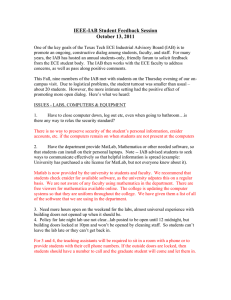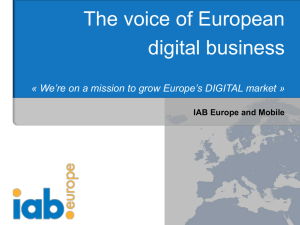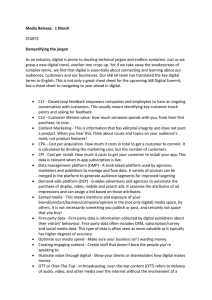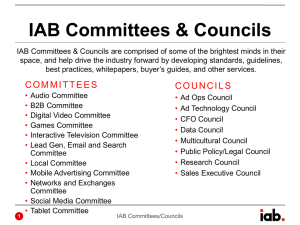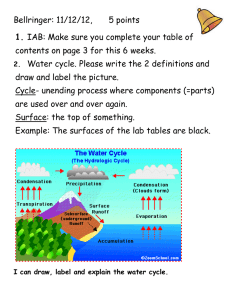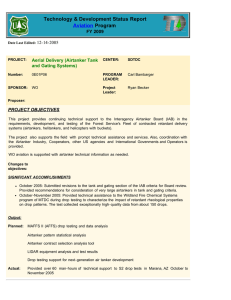Cloud and Autonomic Computing Center (CAC) Bylaws Version 1.1
advertisement
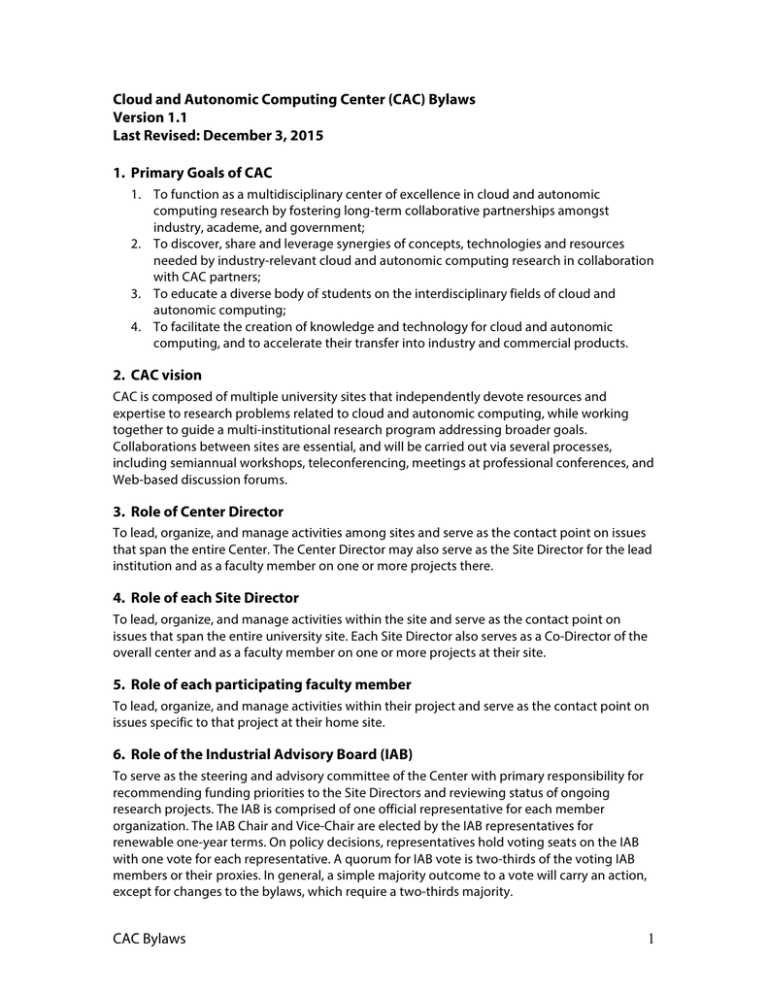
Cloud and Autonomic Computing Center (CAC) Bylaws Version 1.1 Last Revised: December 3, 2015 1. Primary Goals of CAC 1. To function as a multidisciplinary center of excellence in cloud and autonomic computing research by fostering long-term collaborative partnerships amongst industry, academe, and government; 2. To discover, share and leverage synergies of concepts, technologies and resources needed by industry-relevant cloud and autonomic computing research in collaboration with CAC partners; 3. To educate a diverse body of students on the interdisciplinary fields of cloud and autonomic computing; 4. To facilitate the creation of knowledge and technology for cloud and autonomic computing, and to accelerate their transfer into industry and commercial products. 2. CAC vision CAC is composed of multiple university sites that independently devote resources and expertise to research problems related to cloud and autonomic computing, while working together to guide a multi-institutional research program addressing broader goals. Collaborations between sites are essential, and will be carried out via several processes, including semiannual workshops, teleconferencing, meetings at professional conferences, and Web-based discussion forums. 3. Role of Center Director To lead, organize, and manage activities among sites and serve as the contact point on issues that span the entire Center. The Center Director may also serve as the Site Director for the lead institution and as a faculty member on one or more projects there. 4. Role of each Site Director To lead, organize, and manage activities within the site and serve as the contact point on issues that span the entire university site. Each Site Director also serves as a Co-Director of the overall center and as a faculty member on one or more projects at their site. 5. Role of each participating faculty member To lead, organize, and manage activities within their project and serve as the contact point on issues specific to that project at their home site. 6. Role of the Industrial Advisory Board (IAB) To serve as the steering and advisory committee of the Center with primary responsibility for recommending funding priorities to the Site Directors and reviewing status of ongoing research projects. The IAB is comprised of one official representative for each member organization. The IAB Chair and Vice-Chair are elected by the IAB representatives for renewable one-year terms. On policy decisions, representatives hold voting seats on the IAB with one vote for each representative. A quorum for IAB vote is two-thirds of the voting IAB members or their proxies. In general, a simple majority outcome to a vote will carry an action, except for changes to the bylaws, which require a two-thirds majority. CAC Bylaws 1 7. IAB recommendations on funding priorities Proposed new projects are reviewed annually by the IAB. On project decisions, each IAB representative is allocated five (5) voting points with which to influence project selection and resource allocation priorities. Executive members (those with two or more full memberships) are allocated twice as many voting points, for a total of ten (10). Each member’s votes can be allocated all to one project, or among any number of the projects proposed. Each project has a designated minimum threshold of points or memberships needed for support of that project, as defined by the faculty member leading it, and only those projects with sufficient support will be instigated. 8. Meaning and characteristics of a membership levels A full Basic membership each year is one in which the minimum annual fee ($50K)* has been contributed by the industry or government member in cash. Each such membership has associated with it the full rights and privileges of the Center, including but not limited to standard IP rights as defined by I/UCRC in the CAC standard membership agreement and voting rights on center policies and projects. Each full membership is associated with only one of the Center’s university sites, and that membership provides influence in terms of project selection and resource allocation in the Center. Members may hold multiple memberships at one site and/or distributed amongst sites as they deem appropriate. A member with two or more full memberships (cash memberships of $100K or above)* across the Center is designated as an Executive member, with increased voting points towards projects as specified above. * Existing CAC members joining before Dec. 31, 2015 may renew their memberships at $35K per membership per year through 2016. New members joining the CAC before June 1, 2016 may also join at the $35K per membership level ($70K for Executive membership privileges). These membership amounts may be adjusted in the future by revision of these by-laws by majority Board action, subject to NSF requirements and guidelines for center viability and minimum membership criteria. 9. Other types of memberships Other than full memberships funded entirely in cash, all other forms of membership in the CAC will be proposed to and decided upon by the IAB on a case-by-case basis, thereby ensuring that the objectives of the Center are sufficiently furthered to warrant approval. In each case, one of the site directors will formally propose to the IAB a special membership, and that proposal will be approved or rejected by IAB vote. Such additional forms of membership may include in-kind contributions (permitted by the NSF as long as a Basic membership has already been purchased), sponsorship of internships for students, or other material contributions to the operating costs and support of the Center. The Board may decide at its discretion to award additional voting points to a member that makes such contributions to the Center, or to award non-voting status to an organization or individual for technical cooperation with the goals of the Center upon execution of an appropriate cooperation agreement. CAC Bylaws 2 10. Role of the NSF Evaluator The NSF Evaluator works with the Center and site directors to gather data by observation and survey of IAB members and faculty so as to provide objective feedback on Center processes and outcomes and thereby assist in refining Center operations and help ensure that the needs of all members are met. The NSF Evaluator is appointed by the National Science Foundation. 11. Role of each participating graduate student Working in cooperation with Center members, students undertake and complete research tasks assigned by the faculty advisor of the project to which they are assigned, leverage their activities for success in publications, theses, and dissertations all towards graduation, collaborate and work effectively with other students on the same project, and interact with others at the same site and across sites with related interests and activities. Center members and technical cooperation agreement participants may select personnel to work directly with students, in consultation with their faculty advisers and project leaders, to accelerate and accomplish the goals of their projects and to explore, study and propose ideas to the CAC Board for future projects. 12. How research projects support graduate theses for participating students As is typical at research-centric universities, CAC projects will be maximally leveraged to support doctoral and MS theses for its student participants. Although projects are defined, undertaken, and completed on a yearly basis, it is anticipated that a majority of projects in CAC will contain sufficient breadth and depth so as to merit possible continuation for a second and perhaps a third year with the addition of expanded tasks and deliverables. In this manner, a doctoral student serving on a project may leverage key scholarly research components of the project for their doctoral dissertation. The same is true for thesis-option MS students should the work span beyond the first year. 13. Formal schedule for participation Center workshops will be scheduled semiannually, where ongoing and completed research is reviewed (semiannually) and new research projects are proposed and selected for recommended funding (annually). The business of the IAB is conducted at these workshops. These semiannual workshops are tentatively scheduled to occur in the first half of April and in the first half of October each year at rotating university sites. Projects are typically funded to operate for periods that closely match the calendar year and the semester calendar at each university site. Outside of the normal meetings of the IAB at the workshops, the IAB Chair may at his or her discretion call for decisions (e.g., via email or teleconference). 14. Attendance at the semiannual workshops Attendance at the workshops will normally be limited to the following: Center and Site Directors, IAB members and their technical representatives, university faculty, staff, and students participating in the Center, the NSF Evaluator, NSF program managers and staff, and guests invited by the Site Directors with the approval of the Center Director. Guests invited by IAB members, Site Directors or Center Director are required to sign a non-disclosure agreement (NDA) prior to exposure to CAC research materials. CAC Bylaws 3 15. Employing proprietary information from members Given the nature of an I/UCRC and research consortium, and the requirement that all research results from all research projects at all sites of CAC be equally shared with all full members in CAC, the faculty, students, and staff conducting the research will not be able to accept and employ proprietary information in the conduct of projects except in very special and controlled circumstances with the approval of the IAB and the Center Director. For projects that rely on proprietary information or unique requirements, a separate research contract or grant may be the appropriate vehicle (see Section 16). 16. Related research contracts and grants As needs for proprietary research or unique applications may develop, a separate contract or grant may be negotiated between a member and one or more of the university sites in CAC. Such contracts and grants are handled outside the Center membership agreement and would be expected to have confidentiality, patent, copyright, and financial agreements that are different from Center programs. 17. Equipment for research acquired at each site Equipment donations from vendors are highly encouraged and will be supported by visibility on the CAC website (http://www.nsfcac.org) and in various other materials. Some members may choose to donate or loan equipment to support the mission of the Center independent of their membership fee or in very special cases propose to do so in lieu of all or a portion of the costs of an additional membership (see Section 9). 18. Publication review policy As detailed in the standard membership agreement, each university site is free to use the results of its research in CAC for its own educational, research and publication purposes. Research that results in new intellectual property is a relatively rare and small part of an NSF Center’s total output but protected by a publication review policy. In accordance with the agreement, through their IAB representative, each member shall have the opportunity to review a substantively complete draft of any manuscript for possible publication containing results of Center-funded research for thirty (30) days prior to the official submission of that manuscript for publication, and shall have the right to request for cause (e.g., pursuit of patent disclosure) a delay in publication submission not to exceed ninety (90) days from date of distribution to the IAB. 19. Publication review procedure The formal procedure as defined by NSF is as follows: a) A copy of all manuscripts, papers, reviews and other forms of public disclosure relating to Center-funded research shall be submitted to members of the IAB for review prior to publication. For the purposes of disclosure to the IAB under this section, electronic communications (e.g., email) is acceptable only when confirmation of notification receipt has been confirmed. In cases where electronic communications can not be confirmed by return receipt, a physical copy of the manuscript or paper (etc.) shall be sent to the IAB member via certified US Postal Service. CAC Bylaws 4 b) Request for publication delay must be received by the center co-director supervising the research within a 30 (calendar) day period following the date of submission to the IAB. For the purposes of requesting a publication delay, electronic communications (e.g. email) is acceptable. In the event delay notification is not received by the center co-director supervising the research within the 30 day period, public release is assumed approved; c) Any IAB member(s) may delay publication for up to 90 days for cause. In such cases, the University must file disclosures or negotiate license within the allowed 90 day period; CAC Bylaws 5 20. Chairperson The IAB shall annually elect a person from the voting membership to serve as IAB Chairperson. The term of office shall be for a period of 12 months, beginning on the first day of the month following election. The role of the IAB Chairperson is to: 1.Chair the IAB Executive Committee; 2.Administer IAB bylaws; 3.Represent the IAB in CAC business; and 4.Attend and chair all IAB meetings. The Chairperson may delegate these responsibilities to any member of the Executive Committee. 21. Vice-Chairpersons The IAB shall annually elect two persons from the voting membership to serve as IAB Vice Chairpersons. The term of office shall be for a period of 12 months, beginning on the first day of the month following election. Each Vice Chairperson, having equal authority, shall assume the responsibilities and authorities as delegated by the Chairperson. The role of the Vice Chairpersons is to advise and assist the Chairperson in administering the IAB. In the absence or disability of the Chairperson, the Vice Chairpersons shall assume the duties, responsibility and authority of the Chairperson. 22. Secretary The IAB shall annually elect a person to serve as IAB Secretary. The tern of office shall be for a period of 12 months, beginning on the first day of the month following election. The role of the Secretary is to facilitate open and clear communications among the IAB membership, university centers, the NSF and the general public. In this capacity, the duties of the Secretary are to: 1. Create and maintain a written history of IAB proceedings. 2. Publish an agenda for all IAB meetings prior to each meeting. 3. Ensure that minutes of all IAB meetings are recorded and entered into the IAB historical record. Draft minutes of meetings shall be submitted to the Chair for corrections. The corrected minutes shall be submitted for approval at the subsequent semiannual meeting of the IAB. 4. Maintain and insert amendments into the Bylaws 5. Manage and facilitate all communications among the IAB, Executive Committee, committees and membership, universities and the general public. Communications may include, but are not limited to, publication of meeting notes, creation and management of Internet Web sites and press releases. 6. Perform actions as directed by the Chair and members of the Executive Committee. CAC Bylaws 6 23. Executive Committee The Chairperson shall organize an Executive Committee consisting of the Chairperson, Co-Vice Chairpersons, and Secretary. The role of the Executive Committee is to identify and resolve issues of policy, procedure and operations. The Executive Committee shall have the authority to make administrative decisions where time is of the essence and deferring the decision until the next scheduled meeting of the IAB (Committee of the whole) would be detrimental to accomplishing the goals of the CAC. Unanimous agreement is required for decisions on issues affecting the IAB. If unanimity does not exist, the issue shall be decided by the Committee of the Whole. The duties of the Executive Committee are to: 1. Meet and administer IAB business between the meetings of the IAB; 2. Discuss and decide issues as directed by the membership; 3. Cause the Secretary to publish meeting agenda and other communications; 4. Assist in membership drives; and 5. Maintain close liaison with university Center Directors and NSF. 24. Semiannual meetings The CAC shall hold semiannual meetings (or conferences) for the purposes of: 1. 2. reviewing research results; reviewing scholarly papers and presentations; 3. 4. reviewing research proposals; conducting meetings of the IAB; and 5. Accomplishing other CAC business. Semiannual workshops shall be held in the spring and the fall. The location of the semi-annual meetings shall be rotated among the participating universities and approved by the IAB. IAB members may also volunteer to host the semiannual meetings. CAC Bylaws 7
